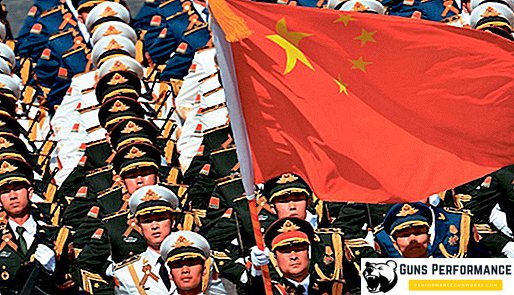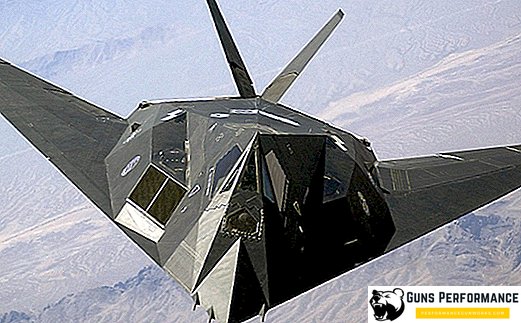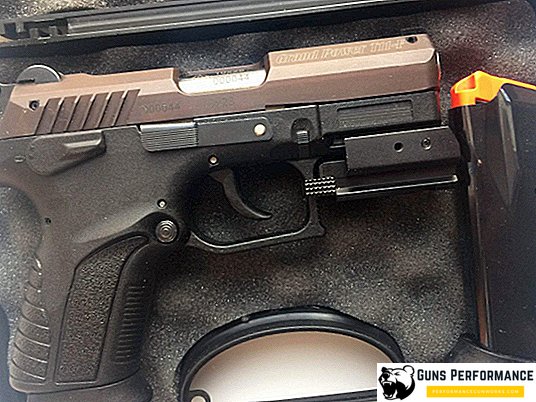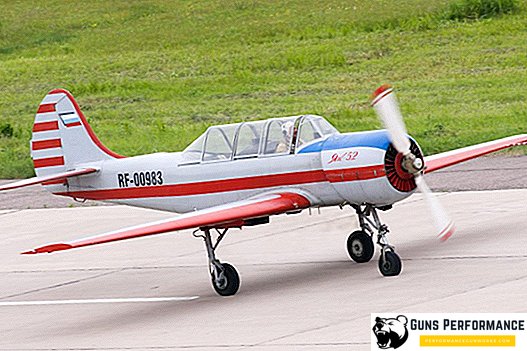Naval rivalry at sea between the United States and the USSR in the mid-60s and early 70s of the last century led to the emergence of new warships, completely unique in their tactical and technical characteristics.
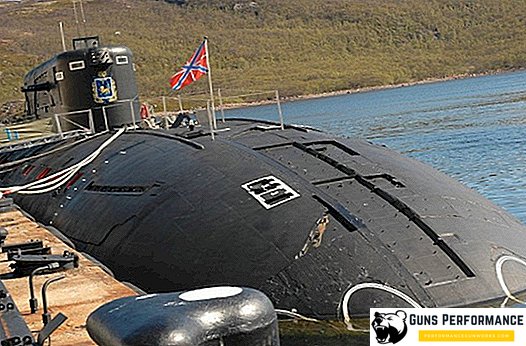
By that time, the Americans had managed to achieve a significant breakthrough in the military-technical area, launching modern "third generation" nuclear submarines. The ships were equipped with low-noise propulsion systems and powerful rocket and torpedo weapons. The response of the Soviet Union to the attempt to achieve superiority of the West in the naval sphere became the submarines of project 945, unique warships of their kind.
The main goals of the project 945 submarine
The multipurpose Los Angeles-class multi-purpose nuclear submarine that appeared in the US Navy allowed the Americans to gain supremacy in the ocean for a short time. Previously, the main type of armament of the submarine of the 2nd generation, significantly inferior in many technical parameters to new American ships. The USSR at some time was defenseless in the face of the threat of a break-through of the sea’s borders by a submarine force of a potential enemy. Only timely adequate measures by the Soviet military-industrial complex could turn the situation back on track. The Project 945 submarine ship, named Sierra I by Western classification, was created with the sole purpose of detecting the potential enemy submarines in a timely manner and being ready for their destruction.
The new submarine was to have the necessary secrecy, high speed and great firepower.
Initially, the technical requirements for the new ship were announced mandatory conditions that should have a new submarine. The hull should be double with the most efficient from the point of view of hydrodynamics, contours. The power plant must have one atomic reactor of reduced size, which will provide the ship with high speed characteristics.

In addition to the high technical characteristics of the new ships, an obligatory condition was set before the creators of the project. All ships of the new series should have a displacement and dimensions that fit into the power parameters of the ship repair and shipbuilding industry of the USSR. The task assigned to Soviet designers in 1972 was to build a new submarine of the 3rd generation in the next 3-5 years. For this purpose, the terms of reference provided for the development of a project for the subsequent construction of nuclear submarines at the Central Design Bureau Lazurit located in Gorky. The technical assignment assumed the construction of submarines on a competitive basis. In parallel with the development of the project 945 was intensive work on another project. On the basis of the same technical assignment and sketch data of the design bureau Malakhit was engaged in the design of its ship, a multi-purpose submarine of the Pike type - project 971.
For 7 years, hard work has been done to create new ships. The result of the titanic efforts of Gorky designers was the project 945 submarines of the type "Barracuda". The laying of the head ship of the nuclear-powered submarine series Karp took place in 1979 at the Gorky shipbuilding plant Krasnoye Sormovo. In the future it was planned to build another ship on the Sevmash stocks.
Development and creation of the project ship 945
The design of the 3rd generation of boats began in 1972. All technical documentation on the new project was created in Gorky (now Nizhny Novgorod) Central Design Bureau "Lazurit". The shipyard "Krasnoye Sormovo", located here in the city of Gorky, was originally chosen as the place for the project.

The submarine of the project 945 radically different from all previous submarines of this class. It was supposed to build a ship, the hull of which will be made of titanium alloy. This innovation gave significant weight savings, making the displacement parameters of the new submarine acceptable to domestic shipyards. In addition, the titanium hull had greater strength, which automatically increased the depth of immersion of the new ship. The titanium alloy from which the main body of the submarine was made had low electromagnetic characteristics, providing the warship with good stealth in the water column.
Despite the high technical characteristics of the Barracuda-type submarine, the only Achilles heel of the 945 project is the titanium case. This innovation, used in the design, led to a significant increase in the cost of construction of the ship.
For reference: according to experts of the Project 945 nuclear submarine treated the state treasury for that period in a whopping amount - $ 300 million, which was equal to the amount spent on the construction of 2 submarines of the "Los Angeles" type.
Ship hull
Multi-purpose submarines of the "Barracuda" type were built double-hulled. This concept not only increased the tactical and technical characteristics of the ships, but also made it possible to rationally use the technical capabilities of the titanium alloy. The main hull was made entirely of titanium, while the bow and stern ends of the boat hull had a steel structure. The shape of the light body had perfect hydrodynamic contours - an ellipsoidal nose and a spindle-shaped stern. The solid main body had a conical shape, both in the bow and in the stern. All bulkheads in the ends of the ship were spherical, and the structure mounts could easily be subjected to bending stresses in the hull when diving to a depth.

The entire ship was divided into 6 combat compartments. Ballast tanks were equipped with kingpin type. In addition, the design of the ship provided for the installation of an ascent emergency system. Blowing of tanks was carried out not by compressed air, but by the products of fuel combustion during the operation of auxiliary diesel engines. To evacuate the team in emergency situations, the boat was equipped with a rescue capsule installed in the area of the central combat post. The new boat had a practical immersion depth of 480 m, while the maximum allowable immersion limit reached 550 m.
The boat in the surface position had a displacement of 5940 tons. The dimensions of the vessel were: length 107 m, and width 12 meters. Such measurements made it possible to carry out a ready-made ship with a system of river channels from the stocks to the place of subsequent registration. In the future, the boats were free to undergo a scheduled maintenance inspection at almost all ship repair enterprises of the Soviet military industrial complex.
The crew of the submarine was 61 people.
Power point
The submarine of the project 945 "Karp" - the head submarine of the series has a power plant with a capacity of 43 thousand horsepower. The operation of the steam-toothed installation is ensured by a single OK-650A nuclear reactor. The design of the reactor has 4 steam generators, which, together with the pumps, provide the necessary circulation of coolant through four circuits. The resulting electricity from the nuclear installation is used to charge the batteries and a group of converters.
In the operating mode during normal reactor loading, the power plant provides the submarine with a surface speed of 12 knots. In the submerged state, the submarine develops a speed of 35 knots.
The ship has an increased autonomy of navigation, which is at least 100 days.
However, in addition to the head of the power plant, providing the life and work cycles of the submarine cycle, the ship has two diesel engines. The task of diesel engines is auxiliary. In emergency situations, the motor group must provide the submarine with an autonomous power supply and a course of 5 knots for 10 days.
The ship has as a propulsion propeller with improved hydrodynamic contours. The reduced screw rotational speed used on boats of this type makes submarine movement under water hardly noticeable.
After the delivery of the first two vessels, the project 945 has undergone some changes. A new reactor is being installed on the boat. Changed and submarine armament. Subsequent ships belonged to Project 945A.

In total, for 8 years, from 1979 to 1987, two submarines of the project 945 were put into operation. The submarine - "Crab". Both ships have different fates. The firstborn of the series, the submarine "Karp" was decommissioned in 1998. The second ship of the Krab submarine series, which received a new name for the Kostroma in 1996, is still part of the Russian fleet.
Armament of Project 945 submarines
Soviet multipurpose boats were to serve as a counterweight to the American Los Angeles-class combat submarines, which announced the hunt for Soviet submarine-carrying submarines. To perform combat missions, Soviet submarines of Project 945 were equipped with torpedo-mine armament, represented by the RPK-6 Vodopad and RPK-7 Vet combat complexes.
These combat modules had a caliber of 533 mm and 650 mm, respectively. The main combat shells of the Barracuda-type submarine were torpedoes and torpedo-launched missile torpedoes. The ammunition of the boat in the equipped state was 40 torpedoes and rocket-torpedoes.
The main weapon of the Project 945 submarine was the torpedo TEST - 71, the combat part of which could inflict critical damage on the ship of the probable enemy. The new torpedo had an active-passive type homing system, which made its movement almost imperceptible to the enemy.

In addition to torpedoes with conventional warheads, the ships were equipped with Veter anti-submarine torpedoes with a nuclear warhead.
The electronic armament of the Barracuda-type submarine consisted of the SKAT sonar complex. Low noise level when the ship is moving under water and the presence of new sonar equipment increased the stealth of the ship. The accuracy of determining the coordinates of the vessel with the help of new equipment has increased 5 times. The range of direct communication of the ship with the base has increased several times, exceeding the previous figures for the Soviet submarine fleet by 2-3 times.
The emergence of submarines project 945A
After the improvement of the power plant and the reinforcement of the armament of the ships based on the existing project, new submarines of the Condor-type project 945A appeared. At the stage of laying the 3rd and 4th ships of the series, an attempt was made to prepare the ships for the installation of the upgraded OK-650B reactor. The power plant capacity increased to 48 thousand hp New thrusters were installed on the boats, improving the ship's maneuverability in combat conditions. The size of the ships remained unchanged, but their displacement increased to 6,400 tons. All also the crew of the submarine is 61 people. Major changes in the design touched the combat capabilities of the new ships. The introduction of constructive changes in the ship’s weapons system led to the number of compartments in the 945A boats reaching 7.
Submarines armed with six 533-mm torpedo tubes. However, strategic cruise missiles "Granat" became the main weapons of the warship. One submarine carried up to 10 missiles with conventional and nuclear warheads. The launch of cruise missiles was to be carried out through torpedo tubes. The ships of the Condor type were armed with the Igla MANPADS, which strengthened the air defense system of the military courts.
The modernized ships received in NATO terminology the name "Sierra II". The first submarine of an improved type was put into operation in 1990, having received the name "Catfish". In 1995, the ship was renamed the Nizhny Novgorod, becoming a multi-purpose submarine project 945A.
The second ship of the series of the submarine "Okun" was laid in 1989 and entered service in 1992, join the ranks of the Russian Navy. In 1995, the boat received a new name, becoming the submarine "Pskov". Further construction of the new submarines was discontinued. The next modernization of the combat capabilities of the ships led to the laying of a submarine project 945B (code "Mars"). However, due to the difficult financial situation in the country, it was decided not to build expensive titanium submarines in the future.

Today, the list of the Russian Navy includes all four titanium submarines. The submarines "Tula" and "Kostroma" are located at the wall of the ship-repair factory, awaiting their future fate. Newer ships, the Pskov submarine and its sister, the Nizhny Novgorod nuclear submarine are listed as part of the 7th submarine division of the Northern Fleet with a base in Vidyayevo. It is planned to re-equip all four ships in accordance with the technical specifications of the project 945M and arm the ships with Caliber cruise missiles.


